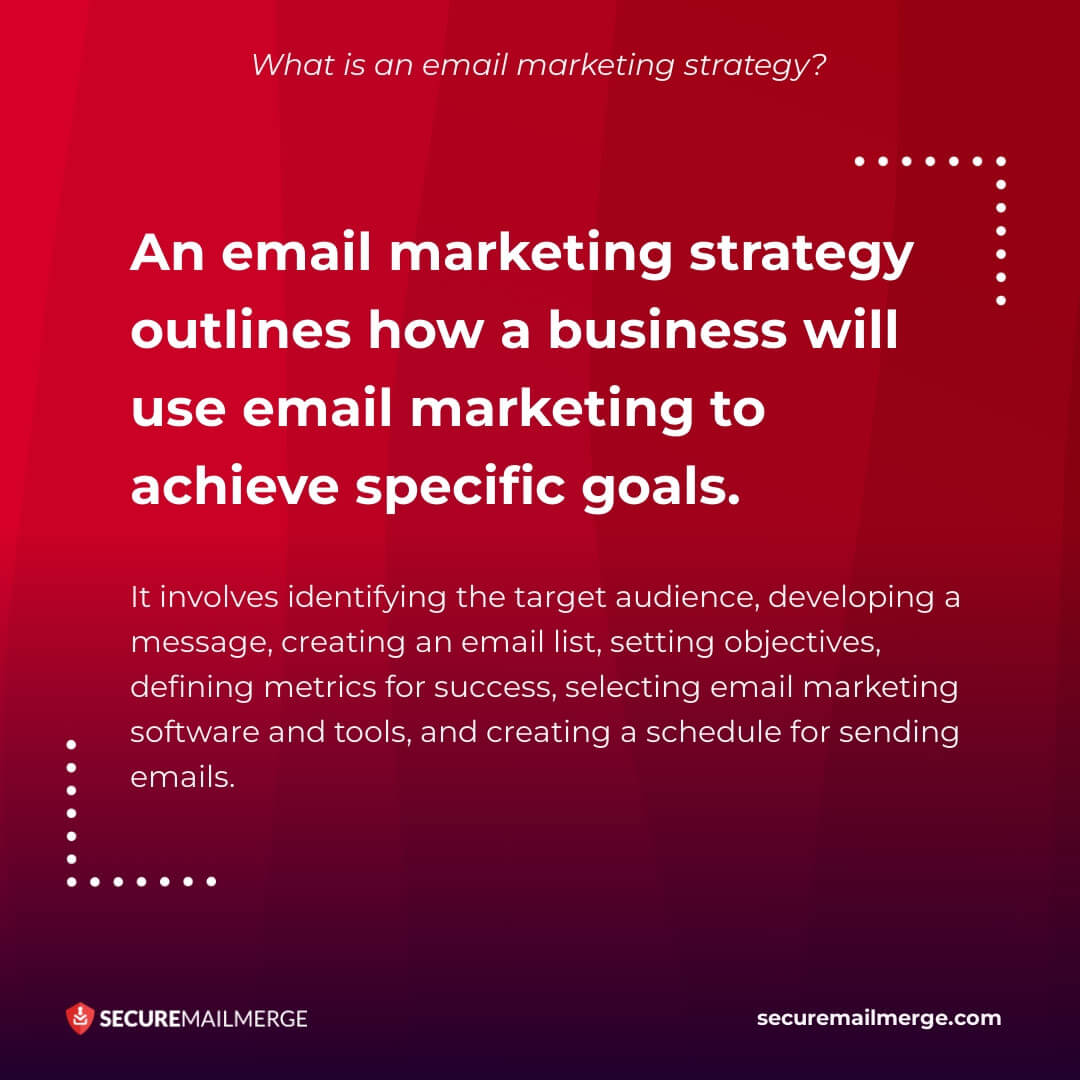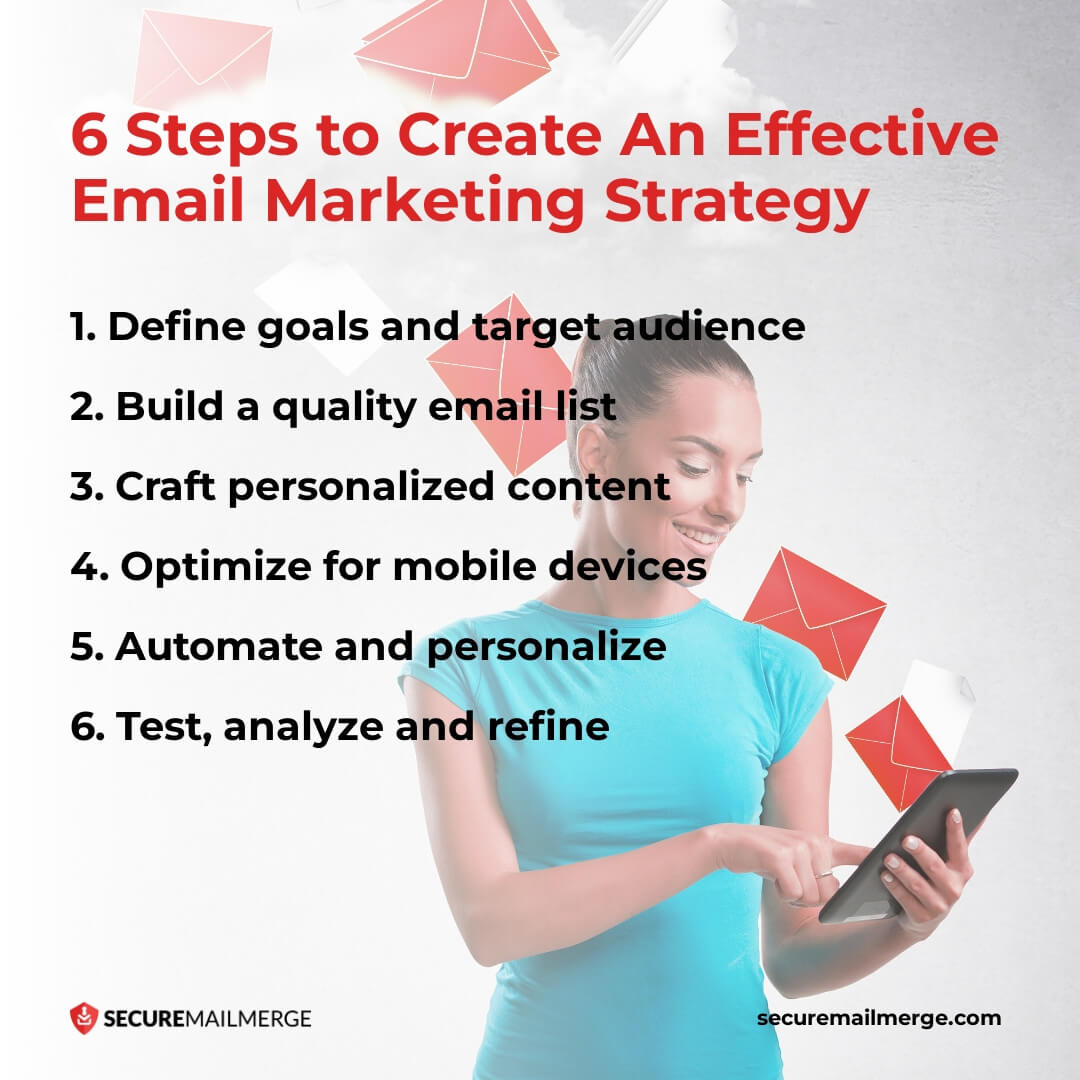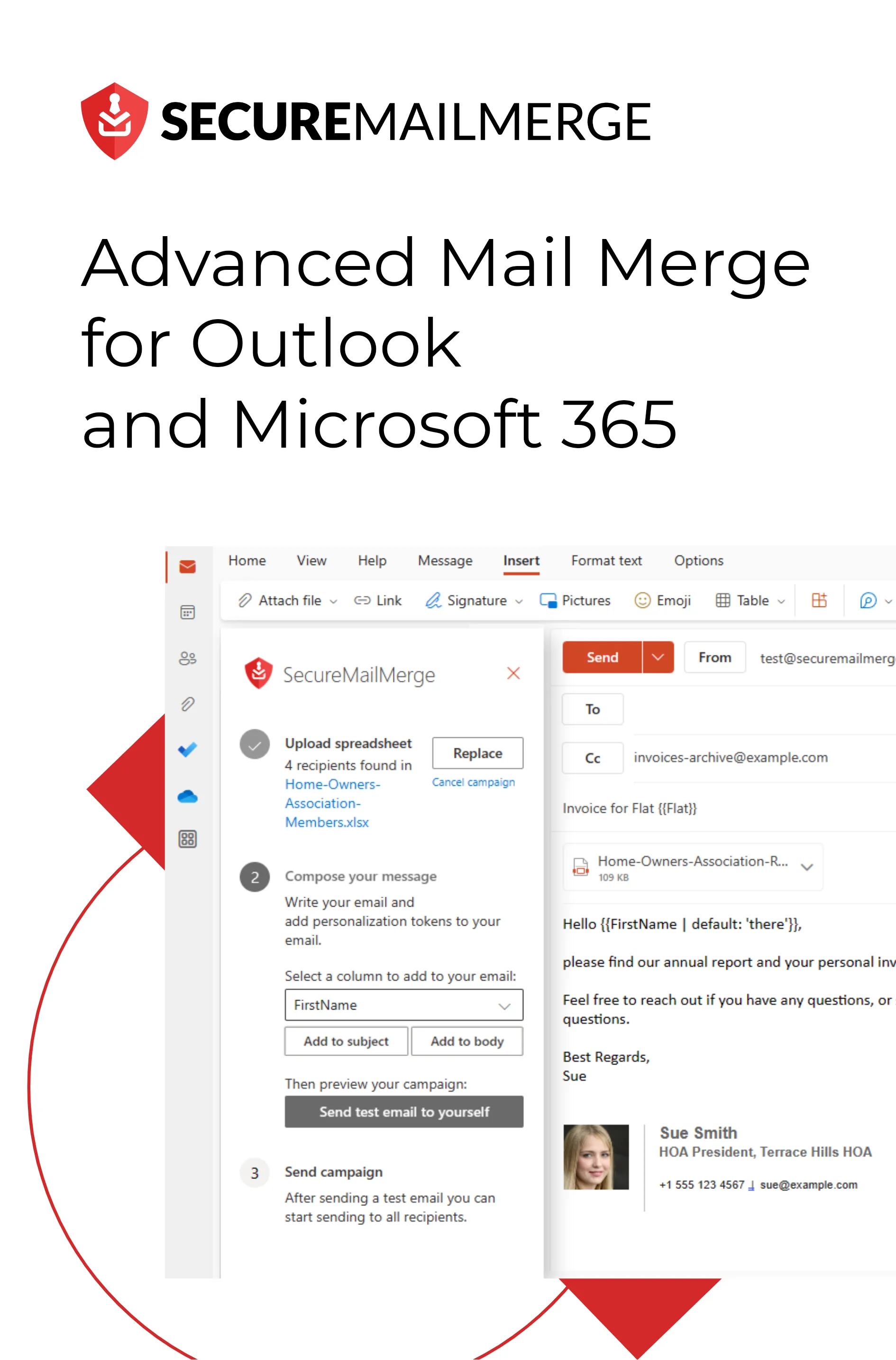Know how directly from the Microsoft 365 mail merge experts
Wie man eine erfolgreiche E-Mail-Marketing-Strategie im Jahr 2023 erstellt
Mit über 4,37 Milliarden E-Mail-Nutzern ist E-Mail-Marketing eines der effektivsten digitalen Werkzeuge für Unternehmen geworden, um mit ihrem Publikum in Kontakt zu treten. Eine E-Mail-Marketing-Strategie kann die Markenloyalität erhöhen und die Konversionen steigern, wenn sie richtig eingesetzt wird. In diesem Artikel werden wir erläutern, wie man eine erfolgreiche E-Mail-Marketing-Strategie erstellt.
Mit Milliarden von Menschen, die weltweit E-Mails nutzen, bietet es eine einzigartige Gelegenheit, mit Kunden in Kontakt zu treten und Leads zu generieren. Das liegt daran, dass es Unternehmen ermöglicht, ihre Ansprache zu personalisieren und ihre Kommunikation auf verschiedene Marktsegmente und deren Platzierung innerhalb des Verkaufstrichters abzustimmen.
Am Ende dieses Leitfadens werden Sie Folgendes gelernt haben:
- Was eine E-Mail-Marketing-Strategie ist
- Die Einzelheiten zur Erstellung einer erfolgreichen E-Mail-Marketing-Strategie
- 5 Vorteile einer E-Mail-Marketing-Strategie
- 6 Elemente einer erfolgreichen E-Mail-Marketing-Strategie
- 12 bewährte Praktiken zur Erzielung von Ergebnissen
- Empfohlene Tools und Software
- Und Beispiele aus der Praxis erfolgreicher E-Mail-Marketing-Kampagnen.
Lassen Sie uns anfangen!
Was ist eine E-Mail-Marketing-Strategie?
Eine E-Mail-Marketing-Strategie ist ein Aktionsplan, der umreißt, wie ein Unternehmen E-Mail-Marketing nutzen wird, um seine Wachstumsziele zu erreichen.
Sie umfasst Folgendes:
- Identifizierung der Zielgruppe,
- Entwicklung einer Botschaft,
- Erstellung einer E-Mail-Liste,
- Festlegung von Zielen für die E-Mail-Kampagne,
- Definition von Erfolgskennzahlen,
- Auswahl von E-Mail-Marketing-Software und -Tools,
- Erstellung eines Zeitplans für den Versand von E-Mails.

Eine gut gestaltete E-Mail-Marketing-Strategie kann helfen, die Markenbekanntheit zu steigern, den Traffic auf einer Website zu erhöhen, Leads zu generieren und den Umsatz zu steigern. Eine gute E-Mail-Marketing-Strategie sollte auch die Personalisierung und Segmentierung von E-Mails ansprechen, um das Engagement und die Konversionen zu erhöhen.
Es ist wichtig, die Strategie kontinuierlich zu bewerten und anzupassen, um die Leistung zu optimieren und die gewünschten Ergebnisse zu erzielen.
E-Mail-Kampagnen spielen eine entscheidende Rolle im Inbound-Marketing, das darauf abzielt, mit potenziellen Käufern in jeder Phase ihrer Reise zu interagieren. Da die Bereitschaft zum sofortigen Kauf variiert, ist E-Mail ein wichtiges Medium, um eine Präsenz aufrechtzuerhalten.
E-Mail ermöglicht es Ihnen, Ihre Marke im Gedächtnis der Empfänger zu halten, indem Sie personalisierte Nachrichten direkt in deren Postfächer liefern. Durch den Einsatz von Marketing-Automatisierungstools wie SecureMailMerge für Outlook 365 oder MailChimp können Sie diese Kommunikation in großem Maßstab erreichen.
5 Vorteile einer gut gestalteten E-Mail-Marketing-Strategie
Eine gut gestaltete E-Mail-Marketing-Strategie kann Ihr Unternehmen in mehreren Bereichen erheblich beeinflussen.
Einige der wichtigsten Vorteile sind:

1. Erhöhte Reichweite und Markenbekanntheit
E-Mail-Marketing ermöglicht es Unternehmen, sofort mit einem großen Publikum in Kontakt zu treten. Mit Milliarden aktiver E-Mail-Nutzer weltweit können Unternehmen potenzielle Kunden aus verschiedenen demografischen und geografischen Standorten erreichen und ihre Reichweite über traditionelle Marketingkanäle hinaus erweitern.
Unternehmen können verschiedene Kundenprofile erschließen, indem sie Engagement-Produkte wie Kundenfeedback-Formulare, Anmeldungen für Belohnungsprogramme, Newsletter-Abonnements oder Einzelhandelsaufnahmeformulare für Online-Bestellungen erstellen. Diese Profile geben Unternehmen Einblicke in ein umfangreiches Netzwerk von ehemaligen, aktuellen und potenziellen Kunden.
2. Verbesserte Kundenbindung
E-Mail-Kampagnen bieten eine hervorragende Gelegenheit, persönlich mit Kunden in Kontakt zu treten. Indem Sie relevante und wertvolle Inhalte direkt in deren Postfächer liefern, kann Ihr Unternehmen ein Gefühl von Loyalität, Vertrauen und Markenaffinität unter seinen Abonnenten fördern.
Zum Beispiel könnte eine lokale Kosmetikmarke monatliche Newsletter mit Tutorials zum Erstellen beliebter Make-up-Looks mit ihren Produkten versenden. Abonnenten könnten frühere Kunden oder sogar nur Kosmetik-Enthusiasten sein. Solange die Inhalte einen Mehrwert bieten, sind engagierte Zielgruppen eher bereit, zu konvertieren, wiederkehrende Käufer zu werden oder für die Marke zu werben.
3. Kostenwirksames Marketing
Im Vergleich zu traditionellen Marketingkanälen bietet E-Mail-Marketing eine kosteneffektive Lösung. Es entfällt die Notwendigkeit für Druck, Werbeflächen oder gesponserte Inhalte, was es zu einer budgetfreundlichen Option für Unternehmen jeder Größe macht. Die Automatisierung dieses Prozesses kann Ihrem Unternehmen wertvolle Zeit sparen und gleichzeitig eine sinnvolle Ansprache und einfache Kampagnenverfolgung gewährleisten.
Anstatt für verschiedene gezielte Anzeigen für unterschiedliche demografische Gruppen zu bezahlen, können Benutzer eines integrierten Mail-Merge-Plugins wie Secure MailMerge für Outlook E-Mails einfach anpassen und Informationen an einem Ort speichern.
4. Hilft Ihnen, gezielte und angepasste Inhalte zu erstellen
E-Mail-Marketing ermöglicht die Segmentierung von Abonnentenlisten basierend auf Demografie, Vorlieben oder Verhaltensweisen.
Der Monat Dezember erfordert in New York City ganz andere Modeentscheidungen als beispielsweise in Sydney, Australien. Daher könnte eine globale Bekleidungsmarke relevante Angebote entsprechend dem geografischen Standort ihrer Kunden versenden und so den einzigartigen Umständen, Bedürfnissen und Interessen ihrer verschiedenen Kundenbasis gerecht werden, um eine höhere Interaktion und Konversionen zu erzielen.
5. Bietet hilfreiche Einblicke
E-Mail-Marketing-Plattformen bieten wertvolle Analyse- und Berichtsfunktionen, mit denen Sie den Erfolg Ihrer Kampagnen messen können.
Beispiel: Durch die Verfolgung von Kennzahlen wie Öffnungsraten, Klickraten und Konversionen erhalten Unternehmen umsetzbare Einblicke darüber, was funktioniert und was nicht. Die Leistung einer bestimmten Kampagne kann dann in Bezug auf die Arten von Inhalten, Designs und CTAs bewertet werden, die zu höheren Konversionen führen.
Erfolgreiche Beispiele für E-Mail-Marketing in der Praxis
Spotify
Spotify sendet seinen Nutzern regelmäßig E-Mails, um auf neue App-Funktionen, personalisierte Playlists und neue Musikveröffentlichungen aufmerksam zu machen. Diese E-Mails sind kurz, leicht zu überfliegen und enthalten CTA-Buttons, um den Verkehr zurück zu ihrer Streaming-Plattform zu lenken.
Warum es funktioniert: Die Fähigkeit von Spotify, seine E-Mails basierend auf den Hörgewohnheiten und Interessen der Nutzer zu personalisieren, schafft ein Gefühl von Exklusivität und Relevanz, was die Markenloyalität stärkt. Jede Empfehlung hat einen erkennbaren CTA-Button, der sicherstellt, dass die Nutzer genau wissen, was sie beim Klicken erhalten.
Starbucks
Einfach, kurz und prägnant, besteht der monatliche Newsletter von Starbucks typischerweise aus nur einem Hauptbild, gefolgt von einem CTA, der das Publikum auffordert, mehr zu erkunden. Das Hauptbild zeigt in der Regel einen neuen oder saisonalen Artikel.
Warum es funktioniert: Durch die Präsentation von nur einem Hauptbild, das normalerweise einen neuen oder saisonalen Artikel zeigt, zieht Starbucks die Aufmerksamkeit auf sich und weckt Neugier. Der singular Fokus ermöglicht es dem Publikum, die Hauptbotschaft ohne Ablenkungen leicht zu erfassen. Die Einbeziehung eines klaren und überzeugenden Call-to-Action (CTA) ermutigt die Leser, weiter zu erkunden, und treibt sie dazu, die Starbucks-Filialen oder deren Online-Plattformen zu besuchen.
Sephora
Die E-Mail-Marketing-Strategie von Sephora dreht sich darum, seinen Abonnenten einen Mehrwert zu bieten. Sie senden personalisierte Produktempfehlungen basierend auf früheren Käufen, exklusive Angebote, Schönheitstipps und Tutorial-Videos.
Warum es funktioniert: Durch die Anpassung seiner E-Mails an individuelle Vorlieben und Bedürfnisse schafft Sephora ein Gefühl von Gemeinschaft und Loyalität in seinem Publikum. Der Fokus des Newsletters liegt auf dem Aufbau langfristiger Beziehungen, indem wertvolle Inhalte geliefert werden, die über den reinen Verkauf von Produkten hinausgehen.
6 Schritte zur Sicherstellung einer effektiven E-Mail-Marketing-Strategie
Eine effektive E-Mail-Marketing-Strategie kann Unternehmen dabei helfen, ihre Ziele zu erreichen und starke Beziehungen zu ihrem Publikum aufzubauen. Wie jede erfolgreiche Marketingkampagne erfordert sie sorgfältige Planung, Ausführung und kontinuierliche Optimierung.
Um den Erfolg Ihrer E-Mail-Marketing-Kampagnen sicherzustellen, definieren Sie Ihre Ziele und Zielgruppe, optimieren Sie für mobile Geräte, personalisieren Sie Inhalte und testen sowie analysieren Sie regelmäßig die Ergebnisse.
Befolgen Sie die folgenden Schritte, um das Unternehmenswachstum durch personalisierte und ansprechende E-Mail-Inhalte voranzutreiben.

Schritt 1: Ziele und Zielgruppe definieren
Bevor Sie in das E-Mail-Marketing eintauchen, ist es wichtig, klare Ziele zu definieren. Bestimmen Sie Ihr Endziel: Möchten Sie den Umsatz steigern, die Markenbekanntheit erhöhen, ein neues Produkt bewerben oder Kundenbeziehungen pflegen?
Sobald Sie ein klares Ziel vor Augen haben, identifizieren Sie eine Zielgruppe. Verstehen Sie deren Bedürfnisse, Vorlieben und Schmerzpunkte, um sicherzustellen, dass Ihre E-Mails effektiv bei ihnen ankommen.
Schritt 2: Eine qualitativ hochwertige E-Mail-Liste aufbauen
Eine E-Mail-Liste ist die Grundlage einer guten E-Mail-Marketing-Strategie. Konzentrieren Sie sich darauf, eine organische Liste engagierter Abonnenten aufzubauen, die sich freiwillig für den Erhalt Ihrer Mitteilungen entschieden haben.
Eine Möglichkeit, diese Kundendaten zu erfassen, besteht darin, Anreize wie exklusive Inhalte, Rabatte oder wertvolle Ressourcen anzubieten, um Anmeldungen zu fördern. Es ist auch wichtig, die Liste regelmäßig zu bereinigen, um die Qualität aufrechtzuerhalten, sie gemäß den sich ändernden Unternehmenszielen zu aktualisieren und inaktive oder unengagierte Abonnenten zu entfernen.
Schritt 3: Überzeugende und personalisierte Inhalte erstellen
Ansprechende Inhalte stehen im Mittelpunkt einer erfolgreichen E-Mail-Marketing-Strategie. Dies ist die direkte Interaktion Ihrer Marke mit dem Kunden. Verwenden Sie einen gesprächigen Ton und gestalten Sie Ihre E-Mails persönlich und nachvollziehbar. Diese E-Mails sollten mit den Interessen Ihres Publikums übereinstimmen, einen Mehrwert bieten und Begeisterung wecken.
Konversion kann hier nicht das Ziel sein. Stattdessen sollten Sie Beziehungen und Vertrauen zu Ihren Abonnenten durch wertvolle und relevante Inhalte aufbauen. Integrieren Sie Storytelling, lehrreiche Inhalte, Werbeangebote oder kuratierte Empfehlungen, um Ihre Leser zu fesseln.
Schritt 4: Für mobile Geräte optimieren
Angesichts der zunehmenden Nutzung von Smartphones ist es entscheidend, E-Mails für mobile Geräte zu optimieren. Die meisten E-Mail-Öffnungen erfolgen mittlerweile auf mobilen Geräten, daher ist es wichtig, dass Ihre E-Mails responsiv sind und auf verschiedenen Geräten und E-Mail-Clients korrekt angezeigt werden.
Verwenden Sie prägnante Betreffzeilen, klare Handlungsaufforderungen und visuell ansprechende Designs, um die mobile Benutzererfahrung zu verbessern. Testen Sie Ihre E-Mails auf verschiedenen Geräten, um optimale Lesbarkeit und Funktionalität sicherzustellen.
Schritt 5: Automatisieren und personalisieren
Nutzen Sie Automatisierungstools, um Ihre E-Mail-Marketing-Bemühungen zu optimieren und die Personalisierung zu verbessern. Richten Sie automatisierte Willkommens-E-Mails ein, um neue Abonnenten zu begrüßen und ihnen Ihre Marke vorzustellen. Weitere Automatisierungen können E-Mails basierend auf bestimmten Aktionen oder Meilensteinen umfassen, wie z. B. verlassene Warenkörbe, Geburtstage oder Kaufhistorie.
Personalisieren Sie Ihre Nachrichten, indem Sie dynamische Inhalte und personalisierte Empfehlungen basierend auf den Vorlieben und Interaktionen jedes Abonnenten einbeziehen. Automatisierung ermöglicht eine bessere Zustellung zeitgerechter, relevanter und personalisierter Inhalte in großem Maßstab und fördert so die Beziehung zwischen Marke und Publikum.
Klicken Sie hier für unseren Leitfaden zur Personalisierung Ihrer E-Mail durch unsere Serienbriefvorlage.
Schritt 6: Testen, analysieren und verfeinern
Um die Effektivität Ihrer E-Mail-Marketing-Strategie zu maximieren, ist es entscheidend, regelmäßige Tests und Analysen durchzuführen - experimentieren Sie mit verschiedenen Elementen Ihrer E-Mails, einschließlich Betreffzeilen, Inhalten, Design und Handlungsaufforderungen.
Führen Sie A/B-Tests durch, um Variationen zu vergleichen und herauszufinden, was bei Ihrem Publikum am besten ankommt. Analysieren Sie die Leistungskennzahlen, die Ihnen Ihre E-Mail-Marketing-Plattform bereitstellt, um Einblicke in Öffnungsraten, Klickraten, Konversionsraten und andere wichtige Kennzahlen zu erhalten.
Nutzen Sie diese Erkenntnisse, um Ihre Strategie zu verfeinern, datengestützte Entscheidungen zu treffen und die Leistung Ihrer E-Mail-Kampagnen kontinuierlich zu verbessern. Führen Sie A/B-Tests durch, um Variationen zu vergleichen und herauszufinden, was bei Ihrem Publikum am besten ankommt.
12 Beste Praktiken zur Erstellung einer erfolgreichen E-Mail-Kampagne
Hier sind einige der besten Praktiken, auf die Branchenexperten schwören, wenn es darum geht, eine erfolgreiche E-Mail-Kampagne zu erstellen.
E-Mail-Design
Visuell ansprechendes Layout
-
Ein gut gestaltetes Layout kann das Auge des Lesers lenken und wichtige Informationen hervorheben, wodurch es einfacher wird, den Inhalt zu erfassen und Maßnahmen zu ergreifen.
-
Ein visuell ansprechendes Layout kann auch zu einem positiven Markenimage beitragen, Vertrauen und Glaubwürdigkeit bei Ihrem Publikum aufbauen und die Wahrscheinlichkeit langfristiger Engagements erhöhen.
Klare und prägnante Inhalte
-
Klarheit und Kürze können die Aufmerksamkeit Ihrer Leser aufrechterhalten und verhindern, dass sie das Interesse verlieren oder von übermäßigen Informationen überwältigt werden.
-
Prägnante Inhalte können die Lesbarkeit und Zugänglichkeit Ihrer E-Mails verbessern, wodurch sie für ein breiteres Publikum leichter konsumierbar werden.
Call-To-Action (CTA) Buttons
-
CTA-Buttons bieten klare und direkte Anweisungen an den Leser und leiten ihn dazu an, eine bestimmte Aktion zu ergreifen, wie z.B. einen Kauf zu tätigen, sich für einen Newsletter anzumelden oder eine Ressource herunterzuladen.
-
Praktische CTA-Buttons sollten ansprechend, leicht verständlich und konsistent mit der Gesamtbotschaft und dem Branding der E-Mail sein, um ein kohärentes und überzeugendes Nutzererlebnis zu schaffen.
Inhalts-Personalisierung
Daten nutzen und sammeln
-
Datenbasierte Erkenntnisse können Ihnen helfen, die Vorlieben, Verhaltensweisen und Interessen Ihres Publikums besser zu verstehen, sodass Sie Ihre E-Mail-Inhalte und -Zielgruppen personalisieren können, um Engagement und Konversionen zu verbessern.
-
Die Nutzung von Daten und Analysen kann Ihnen auch helfen, Trends und Muster in Ihren Zielgruppensegmenten zu identifizieren, sodass Sie effektivere und gezieltere E-Mail-Kampagnen entwickeln können, die mit bestimmten Gruppen von Abonnenten resonieren.
Betreffzeilen und gezielte Angebote
-
Zielgerichtete Betreffzeilen können die Aufmerksamkeit des Lesers erregen und ihn dazu verleiten, Ihre E-Mail zu öffnen, was zu höheren Engagement-Raten und einer verbesserten E-Mail-Performance führt.
-
Maßgeschneiderte Angebote bieten relevante und wertvolle Anreize, die mit den Interessen und Bedürfnissen des Empfängers übereinstimmen, was die Konversionsraten erhöhen und stärkere Beziehungen zu Ihren Abonnenten fördern kann.
Zielgruppensegmentierung
-
Durch die Aufteilung Ihrer E-Mail-Liste in Segmente basierend auf Demografie, Verhalten und Interessen können Sie relevantere und personalisierte Inhalte senden, die mit jeder Gruppe resonieren.
-
Die Segmentierung kann Ihnen auch helfen, Verbesserungsbereiche in Ihrer E-Mail-Marketing-Strategie zu identifizieren, da Sie die Leistung verschiedener Segmente verfolgen und datengestützte Entscheidungen basierend auf deren Verhalten und Vorlieben treffen können.
Informationsmanagement
E-Mail-Zustellraten
-
Durch die Aufteilung Ihrer E-Mail-Liste in Segmente basierend auf Demografie, Verhalten und Interessen können Sie relevantere und personalisierte Inhalte senden, die mit jeder Gruppe resonieren.
-
Die Segmentierung kann auch helfen, Verbesserungsbereiche in einer gegebenen E-Mail-Marketing-Strategie zu identifizieren, da Marketer die Leistung über verschiedene Segmente hinweg verfolgen und datengestützte Entscheidungen basierend auf deren Verhalten und Vorlieben treffen können.
Verwalten Sie Ihre E-Mail-Liste
-
Durch die Aufteilung einer E-Mail-Liste in Segmente basierend auf Demografie, Verhalten und Interessen können Marken relevantere, personalisierte Inhalte senden, die mit jeder Gruppe resonieren.
-
Die Segmentierung kann auch helfen, Verbesserungsbereiche in einer gegebenen E-Mail-Marketing-Strategie zu identifizieren, da Marketer die Leistung über verschiedene Segmente hinweg verfolgen und datengestützte Entscheidungen basierend auf deren Verhalten und Vorlieben treffen können.
Tracking und Kennzahlen
Definieren Sie die wichtigsten Leistungsindikatoren (KPIs).
-
Verfolgen Sie Kennzahlen wie Öffnungsraten, Klickrate und Konversionen, um wertvolle Einblicke in die Kampagnenleistung über große Datensätze hinweg zu gewinnen.
-
Im Laufe der Zeit können Kennzahlen und KPIs helfen, Trends zu identifizieren, Bereiche mit schwacher Leistung zu erkennen und strategische Anpassungen vorzunehmen, um das Engagement zu verbessern.
Verfolgen zur Optimierung
-
Das Verfolgen von Kennzahlen ermöglicht A/B-Tests von Betreffzeilen, Inhalten und Designs, wodurch Marken Kampagnen durch datengestützte Entscheidungen optimieren und die Gesamtleistung der E-Mails verbessern können.
-
Kennzahlen bieten ein tieferes Verständnis des Verhaltens, der Vorlieben und der Engagement-Muster von Abonnenten, was die gezielte Erstellung von Inhalten und die Segmentierung ermöglicht, um relevantere und personalisierte E-Mails zu liefern.
Compliance
E-Mail-Marketing-Gesetze
-
Da E-Mail-Marketing persönliche Details und Kontaktdaten umfasst, ist es wichtig, sich über Datenschutz- und E-Mail-Marketing-Gesetze im Klaren zu sein.
-
Die Einhaltung von Gesetzen wie CAN-SPAM und der Datenschutz-Grundverordnung (DSGVO) ist entscheidend, um rechtliche Konsequenzen zu vermeiden.
Vertrauen aufrechterhalten
-
Der Respekt vor dem Datenschutz trägt zu einem positiven Markenimage bei, fördert das Vertrauen der Kunden und hilft, langfristige Beziehungen zu Abonnenten aufzubauen, was letztendlich zu einer besseren E-Mail-Marketing-Performance beiträgt.
-
Bewahren Sie das Vertrauen der Abonnenten, indem Sie sicherstellen, dass Ihr Publikum dem Erhalt Ihrer Mitteilungen zustimmt. Stellen Sie sicher, dass Sie explizite Opt-in- und Opt-out-Optionen anbieten, Abmeldeanfragen umgehend bearbeiten und persönliche Daten sicher verwalten.
Wesentliche Elemente einer erfolgreichen E-Mail-Marketingkampagne
Im Folgenden finden Sie eine allgemeine Checkliste, die Ihnen hilft, die Entwicklung und Durchführung einer E-Mail-Kampagne zu optimieren.
Verwenden Sie diese Punkte als Fahrplan, um organisiert zu bleiben und sich auf die Übermittlung wirkungsvoller Nachrichten zu konzentrieren.
-
Klare und ansprechende Betreffzeile: Eine Betreffzeile sollte Aufmerksamkeit erregen und relevant für den Inhalt der E-Mail sein.
-
Personalisierung: Personalisierung trägt dazu bei, dass die E-Mail individueller auf den Empfänger zugeschnitten wirkt und kann die Öffnungsraten und das Engagement verbessern.
-
Ansprechender und relevanter Inhalt: Der Inhalt der E-Mail sollte dem Empfänger einen Mehrwert bieten, leicht lesbar sein und einen klaren Handlungsaufruf enthalten.
-
Mobile Optimierung: Die meisten Menschen greifen über mobile Geräte auf ihre E-Mails zu, daher muss die E-Mail für mobile Bildschirme optimiert sein.
-
Ein sauberes und visuell ansprechendes Design: Das Design der E-Mail sollte visuell ansprechend, markenkonform und einfach zu navigieren sein.
-
Eine gezielte und gut segmentierte E-Mail-Liste: Die Segmentierung der E-Mail-Liste basierend auf dem Verhalten, den demografischen Daten und den Vorlieben der Kunden kann helfen, das Engagement und die Konversionen zu erhöhen.
-
Ein klarer und auffälliger Handlungsaufruf: Der Handlungsaufruf sollte klar, leicht zu finden und den Empfänger ermutigen, die gewünschte Aktion auszuführen.
-
Timing und Häufigkeit: Das Timing und die Häufigkeit der E-Mails sollten auf dem Verhalten, den Vorlieben und den Zielen der Kampagne des Empfängers basieren.
-
Personalisierte Nachverfolgung: Eine personalisierte Nachverfolgungs-E-Mail kann helfen, das Engagement und die Konversionen zu erhöhen.
-
Messbare Kennzahlen: Die Messung und Analyse von Öffnungsraten, Klickraten und Konversionsraten kann helfen, die Kampagne für bessere Ergebnisse zu optimieren.
Werkzeuge und Ressourcen für die E-Mail-Marketing-Strategie
Der Einsatz fortschrittlicher Werkzeuge und Technologien kann die Personalisierung und Automatisierung erheblich verbessern.
Drei wesentliche Werkzeuge, die entscheidend für die Gewährleistung personalisierter und konsistenter E-Mail-Kampagnen sind, sind Customer Relationship Management (CRM)-Systeme, E-Mail-Dienstanbieter (ESPs) und Marketing-Automatisierungsplattformen.
CRM-Systeme
CRM-Systeme sind darauf ausgelegt, Kundeninteraktionen und -daten während des gesamten Kundenlebenszyklus zu verwalten und zu analysieren. Sie ermöglichen es Unternehmen, Kundeninformationen zu speichern und zu organisieren, Engagement zu verfolgen und segmentierte Listen für personalisierte E-Mail-Kampagnen zu erstellen.
Beliebte CRM-Systeme sind HubSpot CRM und Zoho CRM.
E-Mail-Dienstanbieter
E-Mail-Dienstanbieter (ESPs) sind spezialisierte Plattformen, die das Versenden und Verwalten von E-Mail-Kampagnen erleichtern. Sie bieten Funktionen wie E-Mail-Vorlagen, Listenverwaltung und Analysen zur Verfolgung der Kampagnenleistung.
ESPs bieten auch Personalisierungsfunktionen, die es ermöglichen, Kundendaten dynamisch in E-Mails einzufügen. Beispiele für weit verbreitete ESPs sind Mailchimp, Constant Contact und Sendinblue.
Marketing-Automatisierung
Marketing-Automatisierungsplattformen bieten eine umfassende Suite von Werkzeugen, die über das E-Mail-Marketing hinausgehen. Sie ermöglichen es, Marketingaktivitäten zu automatisieren, einschließlich E-Mail-Kampagnen, Lead-Generierung und Kundensegmentierung.
Beliebte Marketing-Automatisierungsplattformen sind Marketo, Pardot und ActiveCampaign.
Ressource für Outlook-Nutzer
Während CRM-Systeme, ESPs und Marketing-Automatisierungsplattformen für effektives E-Mail-Marketing unerlässlich sind, ergänzt Secure MailMerge diese Werkzeuge, indem es spezifische Funktionen bereitstellt, die das Versenden personalisierter E-Mail-Kampagnen direkt aus Outlook vereinfachen. Es bietet Funktionen wie das Versenden maßgeschneiderter E-Mails an kuratierte Listen, die Nutzung von Kontaktdaten aus Tabellenkalkulationen oder Adressbüchern, das Verarbeiten großer Anhänge, die Personalisierung von E-Mails und die Nutzung reichhaltiger Formatierungsoptionen.
SecureMailMerge ist eine bequeme Lösung für Outlook-Nutzer, die die Vorteile von Personalisierung und Automatisierung nutzen möchten, ohne auf separate Werkzeuge oder Plattformen angewiesen zu sein. Die nahtlose Integration in Outlook vereinfacht den E-Mail-Marketing-Prozess und beseitigt die Notwendigkeit zusätzlicher Softwareinstallationen.
Schauen Sie sich unsere Richtlinien an, wie Sie anfangen können, von der Erstellung Ihrer Tabelle bis zum Start des Secure MailMerge-Add-Ins - erstellen und senden Sie Ihre Kampagne ganz einfach aus Outlook.
Hat dir dieser Artikel gefallen?
Wir haben eine ganze Bibliothek mit nützlichen Artikeln für dich zum Lesen.
Zeig mir die Bibliothek der Outlook-Artikel.